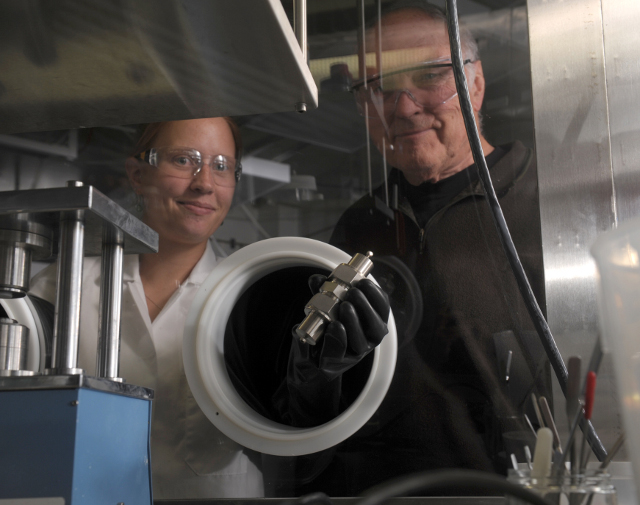Waging an Assault Upon the Battery
UCSB Chemist Lands New Hybrid Technology Grant

As chemists go, UCSB’s Galen Stucky ranks as a certified rock star. In 2004, he won accolades for inventing a special medical gauze that causes blood to clot, but without inflicting second degree burns, then a significant problem with such bandages. For troops in Iraq and Afghanistan, the application — and benefits — of this development were obvious. In 2011, Stucky won an award from his pioneering work in nanotechnology.
This week, Stucky was the lead player in a UCSB research team to win a $1.6 million federal grant to further explore and develop a more user-friendly alternate to the lithium ion batteries now used commercially in gas-electric hybrid motors. Stucky is banking that his new product can be recharged in a matter of minutes rather than hours — eight-to-ten hours being the fast end for many hybrids. In addition, capacitors can be recharged far more frequently than traditional rechargeable batteries.
Stucky, as part of an interdisciplinary team of scientists associated with UCSB’s Institute of Energy Efficiency, will use the federal grant money to explore what materials can best be used on a prototype capacitor, a device that functions similarly to — but is very different from — a battery. Capacitors are superior to traditional batteries in recharge time and frequency; they also are better suited to deliver a sudden surge of power. But the big downside of capacitors is that they can’t store nearly as much electricity as lithium ion batteries. What limits the energy volume of a capacitor — as opposed to a battery — is surface area. Because porous materials offer lots of internal as well as external surface areas, they typically are used in making capacitors. Materials impregnated with nanotubes, presumably, can expand the quantity of surface area as well. But Stucky dismissed the suggestion that the new technology would be based on nano-design.
David Auston, executive director of the Institute for Energy Efficiency, explained the research effort will start off with a patented prototype and involve, among other things, the search for the right materials. Auston noted that this was the first grant the Department of Energy’s Advanced Research Projects Agency had made to UCSB. Joining in the endeavor will be researchers from the University of Oregon and Oregon State. The focus, Auston said, was to develop something with immediate commercial applications. To that end, he said, Stucky would most likely be partnering with a U.S. maker of electric vehicles.
The quest for a better capacitor, while not on par with the hunt for the Holy Grail, is animated by frustration with the recharge time most electric and electric hybrids need. Some take 10-12 hours to achieve a full charge; others four-to-eight. Auston said the capacitors could bring that down to a few minutes. This, he suggested, would eliminate one of the major limitations of hybrids. Capacitors have been around since the 1950s, but they have caught on most recently in hybrid engineering because of their ability to harness the friction created by applying the brakes and using that energy to recharge electric batteries. (The time-traveling DeLorean depicted in the Hollywood movie Back to the Future was powered by the futuristically named “flux-capacitor.”) And unlike batteries, capacitors are not beset by toxic disposal issues.
The research objective, Stucky said, was to create a hybrid fusing the strongest attribute of batteries’ energy storage with that of capacitors to create a device that would weigh even less than current hybrid motors and deliver better mileage than all-gas or all-electric motors. “We hypothesize we can accomplish this,” he said, “but now we have to match our results with what we set out to do.” Stucky noted that 57 percent of all energy currently generated in the United States is wasted. The Institute for Energy Efficiency, he said, was created to reduce this loss, thus obviating some of the need for additional power generation.



